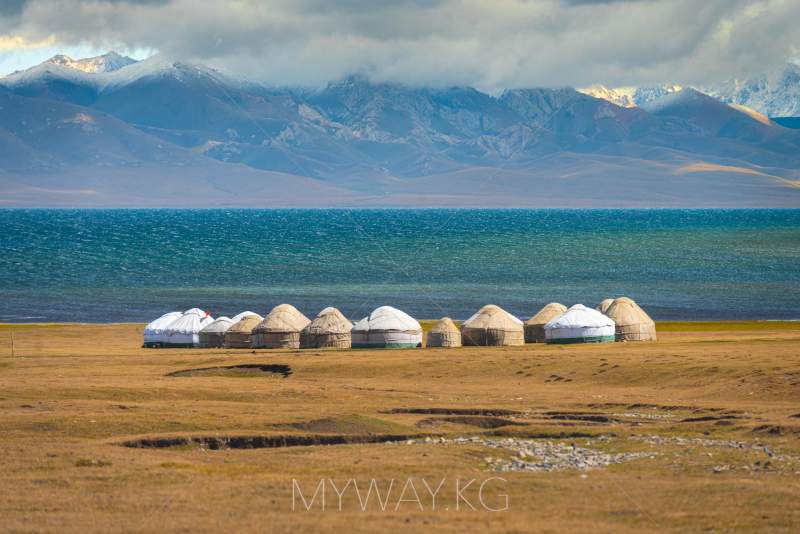 />
/>
Song-Kul Lake: Kyrgyzstan's Majestic Sky Lake
Discover the Pristine Beauty and Nomadic Culture of a High-Altitude Gem
Immerse yourself in the breathtaking landscapes and unique traditions surrounding Song-Kul Lake, a vast and stunning alpine lake where nomadic life thrives in the heart of the Tien Shan Mountains.
Song-Kul Lake, one of Kyrgyzstan's most beautiful high-altitude lakes, presents a stunning tableau of mirrored waters reflecting snow-capped peaks, all embraced by expansive alpine pastures. Each summer, nomadic families converge upon these pastures with their herds, adding a unique cultural dimension to the natural beauty.
As the second-largest lake in Kyrgyzstan, Song-Kul's picturesque shores are defined by alpine meadows where nomadic shepherds graze their livestock, and the crystal-clear water mirrors the boundless sky. Situated at an elevation of 3,016 meters (9,895 feet) above sea level, it is encircled by high mountain grasslands and the towering snow-dusted peaks of the Tien Shan range. The lake stretches 29 kilometers (18 miles) in length and 18 kilometers (11 miles) in width, reaching a maximum depth of 14 meters (46 feet). Its freshwater is exceptionally pure, and during winter, the entire lake freezes over. The surface area of this remarkable body of water is approximately 278 square kilometers (107 square miles).
Fed by over 80 small rivers and streams, Song-Kul has only one outflowing river, also named Song-Kul. In winter, its waters are covered by ice up to 1 meter thick. The surrounding landscape is characterized by alpine pastures, where nomadic communities have traditionally grazed their animals during the summer months.
Song-Kul is shrouded in numerous captivating legends. One tells of an ancient city that once stood where the lake now lies, swallowed by the waters after a powerful earthquake. Another poignant legend describes Song-Kul as the tears of a maiden who lost her beloved. According to this tale, its waters remain eternally pure and crystal clear, like the tears of lost love.
The area surrounding Song-Kul Lake is a tapestry of natural wonders:
Located at an altitude of 3,016 meters (9,895 feet), Song-Kul experiences a sharply continental climate. Summers are short and cool, with an average July temperature of around +11°C (52°F), while winter temperatures can plummet to -30°C (-22°F). The lake typically freezes in October and remains ice-covered until early May. Even during summer, nights are cold, and frost is possible.
Song-Kul Lake is accessible by car from Bishkek (approximately 300 km / 186 miles, a 6-7 hour drive) or from Naryn (approximately 100 km / 62 miles, a 3-4 hour drive). The journey involves traversing scenic mountain passes, including the Moldoo Ashuu Pass (3,346 m / 10,978 ft), Kalmak Ashuu Pass (3,446 m / 11,306 ft), and Terskey-Torpok Pass, each offering spectacular views of the lake and surrounding mountains.
The most convenient routes include:
In addition to the mountain passes accessible by vehicle, numerous hiking trails and passes, such as Tuz-Ashuu, Chil-Bel, and Uzbek Pass, lead to the lake, offering opportunities for trekking, cycling, and horseback riding.
The road to Song-Kul Lake primarily consists of dirt and gravel sections. The terrain becomes more challenging after the mountain passes, especially after rainfall. While accessible to most vehicles in dry weather, it is highly recommended to use 4x4 vehicles for a more comfortable and safer journey.
Song-Kul Lake is a region where traditional nomadic life prevails. Yurt camps are scattered around the lake, offering accommodation and traditional Kyrgyz cuisine. There are no large hotels, shops, or developed infrastructure, which contributes to the area's authentic charm. During the summer months, local nomads offer tourists horseback riding excursions, kymyz (fermented mare's milk) tasting, and insights into their traditional way of life.
The ideal time to visit Song-Kul Lake is from June to September. During this period, the weather is relatively mild, allowing visitors to fully appreciate the natural beauty, stay in yurts, and immerse themselves in the nomadic culture of the Kyrgyz people. Spring and autumn can bring difficult road conditions, and access to the lake is virtually impossible in winter. Be aware that even in late September, snowstorms are possible.
Best Time to Visit
June to September
Altitude
3,016 meters (9,895 feet)
Distance from Bishkek
~300 km (186 miles), 6-7 hours by car
Distance from Naryn
~100 km (62 miles), 3-4 hours by car
Road Conditions
Primarily dirt and gravel, challenging after passes and rain; 4x4 recommended
Accommodation
Yurt camps offering basic lodging and meals
Activities
Horseback riding, trekking, bird watching, exploring petroglyphs, experiencing nomadic culture
Recommended Gear
Warm layers, waterproof jacket, sturdy hiking boots, sunscreen, hat, sunglasses, water bottle